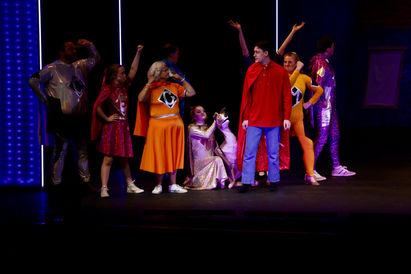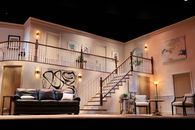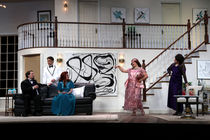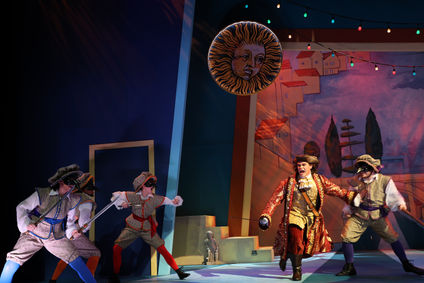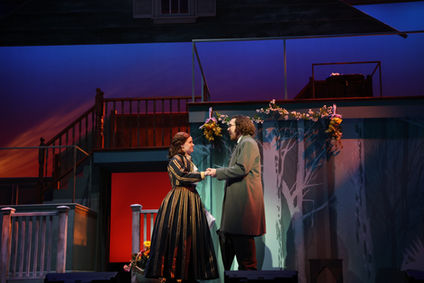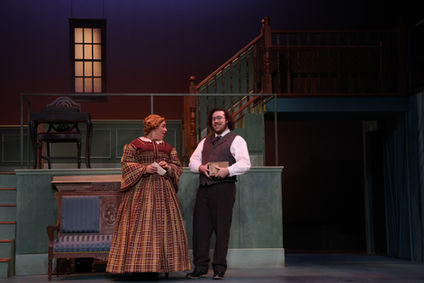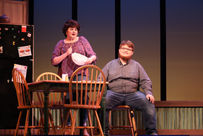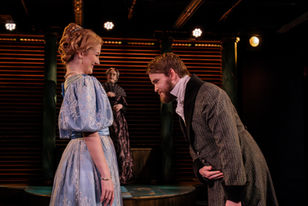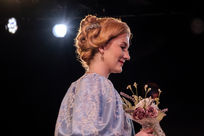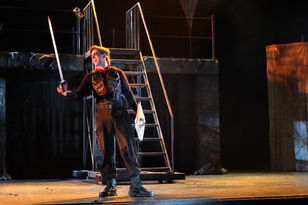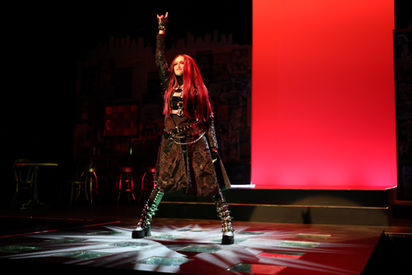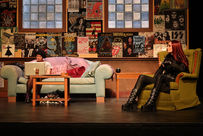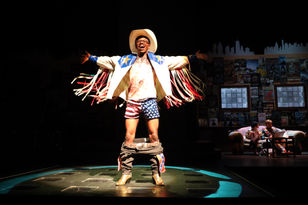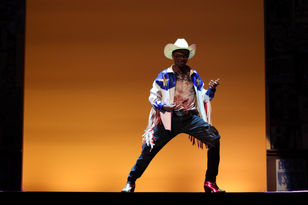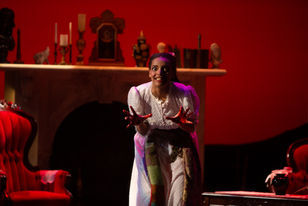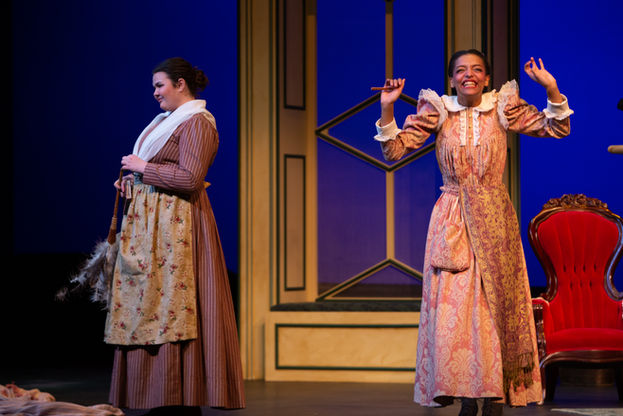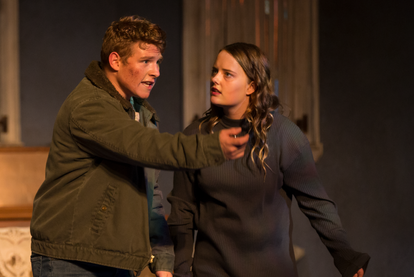Take a deeper look into my sound world......
KANNON GETS THE WIGGLES
A New Musical!
Based on the Children’s Book by Andee Cooper
Book by: Gavin Thomas Drew & Chapman Shields
Music by: Rolin Mains
Directed by: Chapman Shields & KC Lupp
Assistant Directors: Phoebe Jackson & Jessica Frizzel
Choreography by: Kara Staiger
Music Direction by: Rolin Mains
Scenic Design: Chapman Shields
Costume Design: Syd Bradley
Lighting Design: Lucas Mann & Chapman Shields
Sound Design: Harley Roché
Assistant Sound Design: Izy Wilkerson
Stage Manager: Grace Morrison
Master Carpenter: Chip Cooper
Photography by: Ken Blake & Harley Roché
Based on the book by Andee Cooper | World Premiere at the Freeland Center for the Performing Arts
'Kannon Gets the Wiggles' is a heart-filled musical that reimagines epilepsy through the eyes of a child,and I had the honor of designing the sound for its world premiere production. Adapted from Andee Cooper’s beloved children’s book, the show follows young Kannon, whose seizures (or “wiggles”) take the form of vivid comic-book adventures. My design brought his dual realities to life: the grounded textures of daily life, and the stylized, high-energy chaos of his imagination.
From subtle school-day ambiences and structured home sounds to swirling page-turn whooshes, zaps, and fight stingers, the soundscape became a bridge between Kannon’s inner world and the audience’s understanding of it. Professor Lightning—Kannon’s imagined nemesis, was voiced through glitchy and lighting effects, thunderous motifs, and evolving textures that mirrored Kannon’s growing confidence and self-acceptance.
Because the show centers on epilepsy awareness, sensitivity was essential. I intentionally avoided jarring sounds or strobe-like audio patterns, opting instead for smooth transitions, controlled builds, and gentle distortion to reflect perception shifts without sensory overload.
Audiences responded with warmth, laughter, and more than a few tears. Many shared that they had never seen a theatrical story that portrayed epilepsy with such heart, creativity, and care. It was a joy to help bring Kannon’s world to life, and to watch it resonate so deeply in its very first telling.
ALICE BY HEART
Music: Duncan Sheik
Lyrics: Steven Sater
Book: Steven Sater and Jessie Nelson
Director: Liz Bealko
Sound Design: Harley Roché
Assistant Sound Designer: Izy Wilkerson
Lighting Design: Fabian Garcia
Costume Design: Jason Estala
Assistant Costume Designers: Tyler Austin, Christina Burch, Kynzie Gillian, and Stella Green
Scenic Design: Robin Vest-Coleman
Assistant Scenic Designer: Bridget Colatruglio
Production Manager: Marley Giggey
Stage Manager: Jordan Burks
Assistant Stage Managers: Ava Blaskovich and Marisa Wells
Technical Director: Leslie Currell
Assistant Technical Director: Larry Huffman
Photo Credit: John Beier
Designing the sound for Alice by Heart was about more than creating a simple soundscape. This show gave me the opportunity to build an emotional, immersive world that constantly shifts between the brutal reality of war and the fragile escape of imagination.
Set in a London tube station during the Blitz, the show begins in a very real place: the terrifying uncertainty of war. I started with the haunting sounds of that time, most notably, the air-raid sirens. These sirens weren’t just sound cues; they were daily life for millions of people. The warning signal, a rising and falling howl, was the sound of fear, of families rushing to underground shelters, of suspended breath. The all-clear siren, a single, steady tone, marked survival. Relief. A return to “normal,” whatever that meant. I use both in the design as sonic bookmarks, grounding the audience in history while allowing Alice to run away to the fantasy world of wonderland.
But even in fantasy, the real world leaks through.
Alice is a 15-year-old stuck in an impossible situation: bombs are falling, her best friend Alfred is dying beside her, and the world outside is literally crumbling. Her only way out? A book. Her own version of Wonderland. And just like Wonderland, the sound design becomes unpredictable, stretching, distorting, and reshaping as Alice’s grip on reality wavers.
Throughout the show, I used subwoofers, not just for volume, but for presence. Sometimes, the bombs aren't even audible—but the low frequencies vibrate through the space, creating a psychological unease. You feel the war, even in silence.
Time, too, became a major theme in the design. Alfred is our White Rabbit, and he’s running out of time, literally and figuratively. To reinforce this, I built in a ticking motif that follows him around the stage. When he smokes (a moment that mirrors emotional avoidance), the ticking slows… but it never stops. And when he dies? Silence. No ticking. Just loss. That’s one of the audible emotional anchors of the piece.
I also explored voice manipulation throughout Wonderland. The Caterpillars get a laid-back reverb treatment, like they've just stepped out of a fog. When Alice and Alfred "smoke," a slight echo stretches time. It's playful, sometimes surreal, but always rooted in her emotional reality. For the Jabberwocky, we layered on an octave pedal to make his voice sound more like a monster.
One of my favorite moments is the Jabberwocky dance break. Here, the soundscape is chaotic and pounding—voice modulation, rhythmic sub hits, lock sounds, and layered bomb impacts punctuate the music, a reminder that even in the wildest corners of Wonderland, Alice can’t escape what’s happening above ground.
As we approach the final moments of the show, the sound design circles back to something simpler: the garden. Natural, calm, familiar. It’s the place in the story that Alice knows by heart—the part she clings to when everything else falls away.
In the end, my goal was to craft a sonic world that mirrors Alice’s emotional journey: overwhelming, magical, terrifying, and deeply human. It’s a design that asks the audience to feel as much as hear, to be unsettled, comforted, and ultimately moved. Because even in a fantasy, the echoes of reality are never far behind.
SHIPWRECKED!
THE AMAZING ADVENTURES OF LOUIS DE ROUGEMONT: AS TOLD BY HIMSELF
MY REVISITATION TO THIS STORY.
By Donald Margulies
Director: Kathryn Sutton
Sound Design: Harley Roché
Lighting Design: Ben Zimmerman
Scenic Designer: Kathryn Sutton
Costume Design: Cam Schiefer
Accent Coach: Jennifer Hargis
Stage Manager: Lea Parrot
Assistant Stage Manager: Lauren Goza
Tech Operator: Christina Moores
Builder: Chris Rogers
Photo Credit: Ben Zimmerman
Designing Shipwrecked! for the second time was a rewarding challenge—how could I retell the same story in a fresh way, while still honoring its theatrical heart? This play thrives on the blur between fact, fiction, and fantasy, and I used sound to help navigate that transformation.
The design begins with live foley performed by the actors—thunder sheets, rain sticks, and bird calls—inviting the audience into Louis de Rougemont’s storytelling world with transparency and charm. But as his tale becomes more extravagant, the sound shifts: digital effects slowly take over, signaling a story too big for the stage to contain. Flying wombats, breaking masts, sea monsters, and whirlpools come to life through layered soundscapes that blur the line between imagination and delusion.
A recurring handbell, always rung live, grounds us in the present—reminding us that Louis is still steering the ship. Designing this show again allowed me to lean deeper into the play’s theatricality and explore how sound can elevate storytelling, even as the story begins to slip away from the truth.
Rumors
By Neil Simon
Director: Joan Korte
Assistant Director: Chris Bordman
Sound Design: Harley Roché
Assistant Sound Designer: Zane Underwood
Lighting Design: Fabian Garcia
Costume Design: Jason Estala
Assistant Costume Designer: Livvy Higbee
Scenic Design: Robin Vest-Coleman
Production Manager: Marley Giggey
Stage Manager: Carlie Wilson
Assistant Stage Managers: Ava Blaskovich and Marisa Wells
Technical Director: Leslie Currell
Photo Credit: Lee Brasuell
The sound design for "Rumors" is like a carefully woven tapestry, blending realism with dramatic flair. Imagine the audience stepping into an elegant 1980s home, where every sound tells a story. The use of localized speakers transforms the stage into a living, breathing space, where sounds originate from their natural sources - a doorbell's cheerful chime, the sound of an incessant telephone ringing, the distant hum of a car, or the sharp crack of a gunshot from the upstairs bedroom. This design doesn't just fill the space with sound, it places the audience at the heart of the scene, creating an immersive experience where every sound resonates with the authenticity of the moment.
Servant of Two Masters
Originally By Carlo Goldoni
Translated by Rosa Campagnaro
Director: Matthew Smith
Assistant Director: Jaycee Mathews
Sound Design: Harley Roché
Lighting Design: Fabian Garcia
Costume Design: Jason Estala
Wig Assistant: Kyndall Reed
Scenic Design: Robin Vest
Assistant Scenic Designer: Jonathan Sepulveda
Production Manager: Marley Giggey
Stage Manager: Jordan Burks
Assistant Stage Managers: Logan Harper and Allyson Hernandez
Technical Director: Leslie Currell
Photo Credit: Lee Brasuell
The Servant of Two Masters is a fast-paced, comedic masterpiece by Carlo Goldoni, rooted in the traditions of commedia dell’arte. Set in 18th-century Venice, the play follows Truffaldino, a clever but bumbling servant who attempts to juggle two masters at once—without either of them knowing. The story is filled with mistaken identities, romantic entanglements, and hilarious miscommunications, all heightened by exaggerated physical comedy and slapstick humor. This production embraces a hybrid theatrical style, combining classical Venetian influences with modern comedic elements.
Sound plays a crucial role in shaping the energy of the show, utilizing a mix of live foley effects and immersive environmental sounds to transport audiences into the bustling streets of Venice. Music remains classical Italian to ground the setting, while playful sound effects amplify the humor of the performances. The masked stock characters, from the miserly Pantalona to the wily Truffaldino, bring the timeless comedy to life with larger-than-life movements and interactions. Social and political satire, a hallmark of commedia, remains relevant through witty dialogue and dynamic performances. With an emphasis on audience engagement, improvisation, and clever soundscapes, this production of The Servant of Two Masters is a lively, laugh-out-loud experience that bridges the past and present in theatrical comedy.
Little Women
Book by Allan Knee
Lyrics by Mindi Dickstein
Music by Jason Howland
Director: Devon Hunt
Music Director: Eric David Frei
Assistant Music Director: Eleni Konomi
Choreographer: Leah Brown
Intimacy/Fight Director: Matthew Smith
Fight Captain: Logan Harper
Sound Design: Harley Roché
Lighting Design: Fabian Garcia
Assistant Lighting Design: Eamonn Stone
Costume Design: Jason Estala
Wig Assistant: Kyndall Reed
Scenic Design: Robin Vest
Production Manager: Marley Giggey
Stage Manager: Marley Giggey
Assistant Stage Managers: Livvy Higbee
Technical Director: Leslie Currell
Assistant Technical Director: Larry Huffman
Photo Credit: Lee Brasuell
Little Women is a book most everyone has read, seen, or heard of. Little Women to me has been one of my favorite stories since I was a little girl. I could relate to the story of celebrating the enduring bonds of family and sisterhood, the importance of perseverance, and the power of following your dreams. The beloved March sisters – Meg, Jo, Beth, and Amy – go on a heartfelt journey of love, sisterhood, and self-discovery in Civil War-era Massachusetts... but this time with music!! With its stirring melodies, memorable characters, and timeless themes, this musical adaptation of Louisa May Alcott's classic novel was quite the show to create.
Sound’s importance in this show in a solid balance of the band, vocals, and the addition of environment atmosphere sounds.
The audio files below were voiceovers I had put in Act 2 Scene during the song "The Fire Within Me." In the previous scenes the book characters that would sing, I put a little bit of reverb to distinguish the separate worlds. So in the song, "The Fire Within Me," when Jo starts to write about her sisters, I really wanted to hear her sisters voices again, with the same reverb as used before. This effect was heart wrenching, and when the audience heard Beth's voice for the last time, the feeling in the room was so heavy and profound, and I just thought, sound did that. ;)
The Legend of Georgia McBride
By Matthew Lopez
Director: Chris Alleman
Choreography: Tyrell "Zarah Misdemeanor" Rae (& Drag Consultant)
Sound Design: Ben Whitmore
Live Audio Mixer: Harley Roché
Lighting Design: Katie Gruenhagen
Costume Design: Jess Beyer
Scenic Design: Nic Graves
Props Design: Kathryn Sutton
Stage Manager: Brendan Cullen
Assistant Stage Manager: Audrey Lang
Photo Credit: Graco Hernandez
Casey, a determined Elvis impersonator decked out in a dazzling sequined jumpsuit, sees his world turned upside down when he loses his gig, faces overdue rent, and learns that his wife is expecting a baby! As Elvis exits the stage and a fabulous drag show takes over, Casey must transform and embrace an new stage identity to survive This show was bursting with witty banter, tunes, and thrilling twists that delivered both laughter and insight! I was thrilled to be the audio and live mixer for this unique production. Although it's different from my usual portfolio, I couldn't wait showcase my work! Plus, this show was packed with what Theatre Silco calls "itter Moments," and I just had to show it off!
The Amish Project
By Jessica Dickey
Director: Sara Rodríguez
Sound Design: Harley Roché
Lighting Design: Avery Reagan
Costume Design: Rachel-Anne Germinario
Scenic Design: Kaden Reynard
Props Design: Kathryn Sutton
Stage Manager: Kyrsten Goodrich
Assistant Stage Manager: Camden Hornor
Photo Credit: Graco Hernandez
In an exploration of forgiveness and resilience, *The Amish Project examines the aftermath of a tragic school shooting within an Amish community. Through interconnected monologues, the characters navigate a complex array of emotions: grief, anger, and compassion. Set against the backdrop of profound loss, the narrative encourages audiences to reflect on the transformative power of healing and understanding. My design sought to create an experience that harmonizes reality and fiction, utilizing distorted sounds and varied speaker placements to underscore the play emotional themes. The concept includes distinct auditory representations for characters, such as a low rumbling sound for Eddie and, in contrast, gentle nature sounds for the Amish community. I aimed to gradually build and layer the sounds to emphasize the tension and suspense leading to the play's tragic climax. Following the shooting sequence, I intended for all sounds to cease, leaving the audience in silence. As the Amish community embarks on their healing journey, we gradually reintroduce softer sounds. Ultimately, the experience invites the audience to engage deeply with the themes of loss and renewal.
New feature!
Google has recently started experimenting with an ai tool called Notebook. This is a recording of an ai podcast describing my design. It gives a very good summary of what I did...take a listen!
May We All
By Stephen Snedden
Director: Greg Roderick
Associate Director: Devon Hunt
Music Director: Eric David Frei
Choreographer: Jessica Murphy
Assistant Choreogrpaher: Kyndall Reed
Intimacy Director: Matthew Smith
Sound Design: Harley Roché
Lighting Design: Clara Starkwell
Costume Design: Jason Estala
Scenic Design: Shawn D. Irish
Production Manager/ Stage Manager: Marley Giggey
Photo Credit: Sandi DeVore
Prepare yourself for an amazing adventure in Harmony,, “the town that sings!” Picture a place where music used to flow like a steady stream, but lately, hope has dwindled. Two years ago, local star Jenna Coates embarked on her journey to stardom in Nashville, and everyone believed she was destined for greatness. However, after struggling to find her big break, she returns home without a record deal or a dime to her name, only to discover that Harmony has faced its own challenges. Now, Jenna must confront her reality, reconnect with her loved ones, and reconcile with her past to save herself and the beloved town she cherishes. Having grown up in a small town bursting with dreams I've infused my heart into this concept, capturing the lively environmental sounds that shift with each scene. the vibrant summer cicadas to the soft reverb of voices in a church, sound takes on a life of its own. By the end, you'll be longing to stay in, Tennessee, forever!
Ada and the Engine
By Lauren Gunderson
Director: Joan Korte
Student Assistant Director: Savannah Harrod
Sound Design: Harley Roché
Lighting Design: Clara Starkwell
Costume Design: Jason Estala
Assistant Costume Designer: Jordan Burks
Scenic Design: Eric Barker
Scenic Artist: Lee Brasuell
Production Manager: Marley Giggey
Student Stage Manager: Darcy Golla
Intimacy Director: Matthew Smith
Photo Credit: Garrett Kirksey
Ada and the Engine is the remarkable story of Ada Lovelace. When thinking about women in technology, it may seem as if there were no pioneers. However, Ada was at the forefront of what we know today as technology, and her fingerprints are everywhere. As a female sound designer and audio engineer, I was honored to tell her story. She was a, so I incorporated piano pieces from Debussy, Fauré, Satie, and Ravel. These composers were ahead of their time, but so was she. The opening and closing sequences were very important to me. As I entered this world, I wanted to travel back in time, starting with the iPhone notification and 'whoos' all the way back to the sound of the engine. All the technology sounds we hear today are made possible because of her work. The ending was reversed, and the way it was staged, by the end, Ada is surrounded by her song and the technology sounds of today. She takes it in and realizes that all that was once deemed 'impossible' is happening now. She was right.
Qlab Files
Opening Sequence
Closing Sequence
Macbeth
By William Shakespeare
Director: David Weber
Scenic Designer: Eric Barker
Costume Designer: Jason Estala
Lighting Designer: Graham Darnell
Sound Designer: Harley Roché
Production Manager: Marley Giggey
Student Stage Manager: Katigan Barksdale
Fight Director: Matthew Smith
Text Coach: Joan Korte
Photo credit: Sandi DeVore
The overall concept of the show is a world after destruction. We begin the show with a sound tantrum that fades into an abyss with sounds that we don’t normally hear or sounds that we have heard, but used in new ways. Electricity is limited.
The witches are eerie and magical. It is from another world, a world that is nightmarish.
Ride the Cyclone
Book, Music & Lyrics by Jacob Richmond & Brook Maxwell
Director/Choreographer : Liz Bealko
Music Director: Eric David Frei
Scenic Designer: Lee Brasuell
Costume Designer: Jason Estala
Lighting Designer: Clara Wiebe
Sound Designer: Harley Roche
Production Manager: Marley Giggey
Student Stage Manager: Darcy Golla
Photo credit: John Beier
Ride the Cyclone's central feeling is all about limbo. Blending humor and tragedy, the anecdotes pulled from the children by Karnak beautifully reveal the humanity of the younger generation. My design centered on the vibrant band mix and the microphones in an intimate setting, ensuring that the score and lyrics truly resonate. I recorded sounds that really brought Karnak to life! The finale was another key in my design. The long-anticipated crash finally hits, and while it's a tragedy, there's an unexpected sense of relief that the outside world doesn't quite grasp. I wanted that crash to resonate in the darkness, leaving the audience breathless with anticipation!
Airness
By Chelsea Marcantel
Director: Matthew Smith
Student Assistant Director: Savannah Harrod
Scenic Designer: Eric Barker
Costume Designer: Alyssa Couturier
Lighting Designer: Kathleen Holmes
Sound Designer: Harley Roche
Production Manager: Marley Giggey
Student Stage Manager: Jordan Walters
Photo credit: Sandi DeVore
Airness was an unforgettable experience! While I usually juggle copyright issues and budgets, this show was a dream come true with iconic rock anthems from the 80s and 90s. The only twist? I had to edit each song down to a thrilling 60 seconds, showcasing the most electrifying guitar riffs for an epic air guitar! Collaborating closely with the director and the talented actors, we delivered spectacular performances that had the audience roaring an encore long after the final bows.
Silent Sky
Director: Cameron King
Costume Design: Jason Estala
Projection Design: Bahaar Esfahani
Lighting Design: Clara Wiebe
Scenic Design: Ning Ning Renee Yang
Sound Design: Harley Roché
Hair & Makeup Design: Allison Winsby
Movement Director: Hui Cha Poos
Intimacy Director: Cameron Hamlin
ASL Director: Kaia Fitzgerald
Photo Credit: John Gifford
Silent Sky was a production born from the collaborative efforts of the director and myself, creating a narrative that bridges the years between 1900 and the present day. Henrietta Leavitt, who served as a human "computer" at Harvard University’s Observatory, played a crucial role in mapping the stars yet received little recognition for her contributions. Despite the restrictive gender norms of her era and her struggles with hearing loss, Leavitt developed a for measuring distances on an intergalactic scale, fundamentally altering our understanding of the universe. The musical composition featured a of piano, performed by me, orchestration, and lofi music that enriched the storytelling between scenes. Presented in Science Museum of Oklahoma's Planetarium, the audience was enveloped in a rich tapestry of music and atmospheric sounds allowing us to transport them to another world with the guidance of the stars above.
The moors
By Jen Silverman
Director: Doobie Potter
Costume Design: Jason Estala
Scenic Design: Eric Barker
Lighting Design: Travis Richardson
Sound Design: Harley Roché
Production Manager: Marley Giggey
Student Stage Manager: Liliana Cudly
Photos: Sandi Devore
In the design of The Moors, I drew inspiration from contemporary horror films featuring female protagonists who embody villainous traits, yet ultimately garner viewer sympathy. Key influences include Knives Out, Midsommar, and Hide and Seek. The transitions were crafted in collaboration with Megan Barth Argo, where we reinterpreted Emilie's Song to evoke a range of emotional undertones. I incorporated a creaking sound above the audience to suggest the presence of something looming overhead. The ballad served as the pièce de résistance; I integrated an electric guitar into the provided track and recorded the first half of the vocals, projecting them through various speakers to imply the song originated from Hudley's mind. As the song intensifies, she performs as if in front of a full audience. The piece culminates with the crescendo of audience applause fading into the sound of heavy rain, as she runs into the Moors, never to be seen again.
Slapped!
Adapted by Kevin Douglas
Originally by Leonid Andreyev
Director: David Weber
Costume Design: Jason Estala
Scenic Design: Eric Barker
Lighting Design: Travis Richardson
Sound Design: Harley Roché
Production Manager: Marley Giggey
Student Stage Manager: Leah Anderson
Photos: Sandi Devore
Slapped! is exactly what the title suggests—an exhilarating ride! It was my very first experience workshopping a modern adaptation, and what a journey it was! This tragicomedy beautifully illustrates how even the darkest moments in life can spark laughter through the dazzling artistry of the performance. From the outset, I was captivated by the complexity of the lead character, She. The first act bursts with circus joy and playful confusion, while the second act takes a thrilling dive into She’s deeper story. The music? Absolutely essential! Electrifying tracks from DJ Quad accompanying the circus acts, the silent film scene, the intense mauling moment and She’s unforgettable performance, the music truly drives this incredible tale forward! Slapped! isn’t just a show—it’s was an experience, a whirlwind of laughter, heartbreak, and breathtaking artistry that lingers long after the final bow.
The Immigrant
By Mark Harelik
Directed by Jeffrey Schmidt
Scenic Design: Jeffrey Schmidt
Lighting Design: Philip Vilar
Costume Design: Shahrzad Mazaheri
Sound Design: Harley Roche
Props Master: Claudia V. Jenkins
Accent Coach: Krista Scott
Dramaturgy: Dante Flores
Assistant Director: Merri Brewer
“The Immigrant” was our attempt to keep theatre alive during the pandemic when no one knew what would happen to our community. In collaboration with Theatre Three, the play was performed and recorded in front of a green screen and then live-streamed through the Theatre website. My job as the sound designer was to record, edit, and source the sound effects used. I recorded and edited everything for the show in my Dallas apartment. sound I focused on the most was the prologue. Since this was being live-streamed, we did not the luxury of setting the tone of the show in the space. Because of this, my priority was to create a soundscape that reflected the journey of our protagonist, Haskell Harelik, and his family as they escaped Russia for in Texas. This true, inspiring story brought hope during a time that felt hopeless.
The Three Musketeers
By Ken Ludwig
Director: Lloyd Caldwell
Costume Design: Renee Garcia
Scenic Design: Eric Barker
Lighting Design: Leslie Currell
Sound Design: Harley Roché
Set in 1625 and reimagined with Ken Ludwig’s signature comedic flair, this beloved tale of heroism, treachery, daring escapes, and unwavering honor marked my third sound design project. I crafted a cinematic-style score that propelled the adventure forward, enhancing every twist and turn. One of my proudest achievements was the musket sound effect—created by dropping a bundle of pasta on a table and transforming it in Audacity. This effect, carefully localized on stage, brought the prop muskets to life, immersing the audience in the action and making the world of the play feel all the more real.
The Birds
By Conor McPherson
Director: Andrew Kimbrough
Costume Design: Chloe Mullin
Scenic Design: Lee Brasuell
Lighting Design: Leslie Currell
Sound Design: Harley Roché
The Birds was a milestone in Hitchcock’s career and remains a cornerstone of the horror film genre. As I read the script, I became captivated by the challenge of capturing the raw anxiety that the film evokes—translating its psychological terror into a live theatrical experience.
Our story followed a handful of survivors desperately fighting for their lives as flocks of murderous birds tore through society, bringing chaos and collapse. From the very beginning, sound played a crucial role in immersing the audience. The entire show was underscored, building tension until the final, chilling moment of absolute silence.
When the birds arrived with the tide, I played recordings of hundreds of birds flying overhead, surrounding the audience in an overwhelming cacophony. On stage, windows shuddered under relentless pecking, while our scenic designer used shadow puppetry to create the eerie illusion of birds swarming just outside. And when the tide pulled them away, the silence wasn’t empty—it was pierced by a faint ticking from the back of the theatre and a heartbeat pulsing beneath the stage, a subtle but unnerving reminder that the terror was far from over.
At the center of it all was Diane, our protagonist. Her inner monologues echoed through the theatre, placing the audience inside her unraveling mind. The result was a psychological horror experience that left audiences breathless—perched on the edge of their seats, waiting for the next wave of fear to descend.
Shipwrecked!
By Donald Margulies
Director: Lloyd Caldwell
Costume Design: Jeremey Bernardoni
Scenic and Props Designer: Rich Larsen
Lighting Design: Heidi Hoffer
Sound Design: Harley Roché
Stage manager: Hannah Mans
Shipwrecked! The Amazing Adventures of Louis de Rougemont was the first show I ever designed, and it’s the reason I fell in love with sound. This production embodies what theatre is all about—stripping everything down to the essence of storytelling. With actors seamlessly shifting between multiple roles and the lead character inviting the audience into his astonishing tale of bravery, survival, and celebrity, the show recaptured the wonder that once captivated nineteenth-century England.
The director crafted a world brimming with imagination, and I had the privilege of bringing it to life through sound. Every effect—every creak, crash, and whisper of the high seas—was created from scratch, with live foley performed by the actors. From the snap of a mast to the rush of waves, from the calls of exotic islanders to the flutter of flying wombats, I sculpted an immersive soundscape that wrapped around the audience, making them feel as if they were right there with Louis.
Creativity was key. The waves? They came from recordings of my bathtub, transformed into a vast ocean. Each sound was carefully crafted from ordinary objects to produce something extraordinary—just like Louis himself. His story questions how far we are willing to blur the line between fact and fiction to leave our mark on the world. And for me, this show was a reminder of why we do theatre: to spark imagination, to transport, and to tell unforgettable stories.












